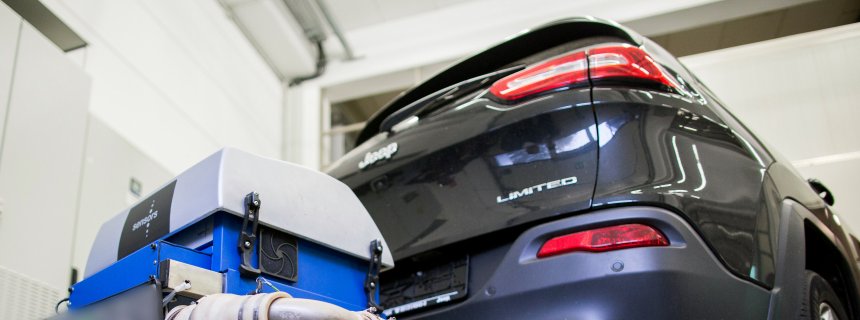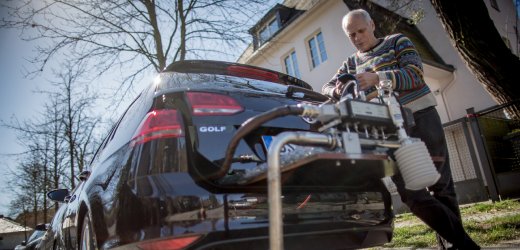Dieselgate in Europe: How Officials Ignored Years of Car Emissions Evidence
ENVIRONMENT, 22 Aug 2016
Markus Becker and Gerald Traufetter – Der Spiegel
When American authorities revealed that Volkswagen used software to trick pollution tests, it spurred widespread outrage. Documents obtained by SPIEGEL show that European officials knew about the deception for years – but didn’t act on it.
19 Aug 2016 – Managers at Volkswagen know with whom they have to maintain friendships. After the then EU Commissioner for Industry and Entrepreneurship Antonio Tajani paid a visit to the company in the spring of 2010, he received a package. “We hope to make you happy with this VfL Wolfsburg jersey signed by the players,” the head of VW’s Brussels office wrote deferentially.
The gift was a complete success. Tajani thanked the VW official effusively, writing that VW was “undoubtedly one of the pillars of German industry.” In a letter written on March 24, 2010 to the man at Volkswagen, he wrote that he had been very pleased by the “souvenir from the 2008/2009 German (football) champion.”
Tajani should have had every reason to be asking the people at VW serious questions instead of sending them thank you letters. For instance, he should have asked why their diesel vehicles were emitting much higher levels of toxic exhaust gases on the road than in laboratory tests performed by approval agencies.
Meeting minutes, correspondence and conversation records that SPIEGEL ONLINE and the Swedish daily Svenska Dagbladet have obtained now show that the European Commission and member states knew, since 2010 at the latest, that the extremely harmful emissions from diesel cars were strikingly higher than legal levels.
But apparently none of the officials wanted the automakers to tell them why this was the case. According to EU officials, pressure from countries with a strong auto industry, most notably Germany, significantly reduced interest in an investigation. Instead of doing something about the environmental policy violation, the Commission and the member states passed the buck to each other. This undignified back-and-forth even continued after the VW scandal about manipulated diesel cars in the United States was exposed in September 2015.
EU Notified Of Problem Early On
The EU bureaucracy was one of the first to be informed, through its research organizations, about the high nitric oxide emissions of the VW vehicle fleet. In 2007, experts with European Commission’s Joint Research Centre (JRC) tested the emissions from operating diesel cars. Additional tests using the so-called PEMS method were performed in 2011 and 2013. The results were the same each time: Nitric oxide (NOX) emissions were several times higher than the levels measured in type approval tests in the laboratory.
Volkswagen was already making an unfavorable impression at the time. The biggest nitric oxide emitter in the 2011 and 2013 tests was a VW Multivan with a diesel engine. This emerges from the list of names of the car models involved, which were not published at the time but has been obtained by SPIEGEL ONLINE. The other eight diesel cars, however, that were randomly selected by the JRC engineers for the PEMS test had the same problem. Be it the Fiat Scudo, Bravo or Punto, the VW Golf or Passat, the Renault Clio or the BMW 120d, not a single model even remotely complied with nitric oxide limits in normal operation.
The resourceful engineers who came up with the PEMS test had accomplished a pioneering feat, but as the minutes from a workshop in November 2010 demonstrate, their successful efforts initially had no consequences. The workshop was attended by representatives of the member states and automakers at the invitation of Tajani’s Directorate-General Enterprise and Industry. As the minutes of the meeting show, diesel cars that had been approved in accordance with the Euro 4 and 5 emissions standards were emitting four to five times the allowable limit of nitric oxide during road operation.
In the workshop, experts from the JRC, as well as from the Netherlands and Great Britain, arrived at a withering assessment. Despite the increasingly stringent Euro standards, they said, the nitric oxide emissions of diesel cars “are (at best) more or less flat,” and they have been so for the last 25 years. In fact, they noted, the percentage of an especially dangerous gas, nitrogen dioxide (NO2), had even increased, because cars with catalyzed soot filters, which had become very common, emitted more of the substance.

A gray haze over Italy in March 2005 — Northern Italy in particular is often faced with serious air pollution.
Tens of Thousands of Deaths Each Year
By that point, the authorities should have been addressing the problem with great urgency: The air quality in many large EU cities was miserable. In 2008, for example, 296 of 821 zones in a total of 21 EU countries reported fine particulate matter levels in the air in excess of allowable thresholds. The NO2 limits were exceeded in 188 zones. Nitric oxides, especially NO2, are considered highly hazardous to health, with the potential to cause breathing problems, inflammation of the lung tissue and asthma. According to an April 2016 statistic by the European Environmental Agency, about 72,000 people in the EU die prematurely as a result of high nitric oxide levels every year.
The Commission identified the main source of the gases long ago. According to the minutes of a meeting of European Commission experts in April 2010, “traffic and especially diesel vehicles are predominant sources of NOx (nitric oxide) and NO2 in urban areas.”
Still, nothing happened. Two years later, in October 2012, the Commission threatened at least 22 member states with infringement proceedings for violations of air quality directives, “mainly due to the exceedance of NO2 concentration levels in ambient air,” reads an internal Commission briefing. To date, the European Commission has launched proceedings against nine countries, including Germany. More countries could follow, say officials.
‘A Very Peculiar Combustion Strategy’
The auto industry tried to throw sand into the eyes of EU officials. They blamed the large discrepancies between laboratory and road tests on the testing procedures. And they argued that people drive differently on the road, and that wind and rolling friction also contributed to the discrepancies.
Experts with no ties to the auto industry stopped believing those arguments long ago. “Exhaust values may vary by 10 percent or so,” says Axel Friedrich, who worked for the German Federal Environment Agency for many years and is now an adviser to the environmental organization Deutsche Umwelthilfe (DUH). “But four to five times as high? That could only be caused by manipulation.”
Friedrich and DUH, together with other environmental organizations, repeatedly informed the European Commission and the German government that the cars were either detecting that they were undergoing a test cycle or were so cleverly programmed that they would only clean exhaust gases to the maximum extent when they were undergoing very specific driving situations during the tests — but not in normal road traffic.
There are indications in EU documents that there were suspicions about the automakers at an early juncture. According to the minutes of the European Commission workshop in November 2010, for instance, a car tested by the JRC emitted extremely high levels of nitric oxide in a low temperature range. “This observation hints towards a very peculiar combustion strategy,” say the experts, speculating that the unusual results could be caused by a device cheating the approval procedures.
This citation in the EU documents is especially damning: After the VW scandal came to light, investigative commissions appointed in various EU countries encountered a “defeat device” in cars from almost every manufacturer that drastically reduced emission control at lower or higher temperatures. The experts used the euphemistic term “temperature window.” After his VW Investigative Commission presented its report, German Transportation Minister Alexander Dobrindt said that this practice by automakers had been unknown until then.
‘Everyone Is Aware of the Problem’
But the public assertions of ignorance by lawmakers and government officials contradict the level of knowledge within government agencies. On July 25, 2012, Industry Commissioner Tajani wrote a letter to the relevant ministers of the member states. In Germany, this was then Economics Minister and chairman of the pro-business Free Democratic Party (FDP) Philipp Rösler. Tajani proposed a “market monitoring system” to ensure that the member states took “corrective action” when cars did not satisfy the requirements for EU model approval or posed a threat to the environment, or “if there are falsifications or manipulations in such products.” Everyone involved, Tajani added, was “aware of the problem.”
A letter Tajani received in February 2013 from then Environment Commissioner Janez Potocnik was even more specific. He wrote that there are “widespread concerns” that engine tuning in cars “has been tailored tightly to compliance with the test cycle in disregard of the dramatic increase in emissions outside the narrow scope.” He alluded to a legal condition that had been in place since 2007, under which cars were required to satisfy emissions standards in both the laboratory and in normal operation — adding that this was apparently not being followed.
Suspicions of illegal activity went on the record again in November 2014, when the EU Directorate-General for the Environment again warned the Industry Commission about “certain current practices documented extensively by the JRC and others.” It described the practices as “emissions-reducing technologies, which are switched off at low temperatures or when the vehicle needs additional power.” According to the letter, it was clear that these practices were subverting exhaust-gas testing during model approval, and that this was a violation of existing laws.
Hear No Evil, Speak No Evil
But Industry Commissioner Tajani, now seen as a possible successor to European Parliament President Martin Schulz, continues to insist that he did not suspect any illegal activity in the auto industry. “I was never informed about the defeat devices or the fraudulent activities that came to light as a result of the VW scandal,” Tajani told SPIEGEL ONLINE. Besides, he added, the US authorities did not discover the defeat devices in VW cars on their own, but rather, it was VW that confessed to its use of the cheating software.
This is true, but VW only acted after US authorities had threatened not to approve the company’s 2016 models. This, in turn, was a result of the massive discrepancies between laboratory results and actual emissions. The EU was well informed about these discrepancies, and had been so for years. So why didn’t the Europeans react as strongly as the Americans?
For one thing, there is the matter of European regionalism. The member states, and not the Commission, are responsible for car type approval, and they were apparently only too willing to look the other way when it came to emissions. Once a national registration authority has rubber-stamped a car, the manufacturer is off the hook. This is handled differently in the United States, where the automaker can be held liable if its products are retroactively shown not to be in compliance with the law.
Besides, the European Commission is not a law enforcement agency, Tajani notes. It can only take action, he explains, “if it has evidence that (a) member state has breached EU law” — and that, Tajani implies, was not the case. This is surprising, though, because the directive on the 2007 Euro 5 and Euro 6 emissions standard explicitly states that the emissions limits apply to actual road operation. The European Commission has known since 2008 that these limits were greatly exceeded.
‘Playing with Fire’
Apparently some at the Commission disagreed with Tajani. It was clear “that the massive discrepancy between test bench readings and actual emissions was hardly legally tenable,” says a Commission official who was involved in the case at the time. He adds that he told the automakers “very clearly: ‘You are playing with fire,'” long before the VW scandal.
But the car manufacturers remained undaunted. And why not? The 2007 EU directive required the member states to define sanctions for violations by Jan. 2, 2009. But the German government, like the other member states, still has not defined any sanctions to this date.
Instead, Transportation Minister Dobrindt cleverly played the ball back into Brussels’ court. When his ministry conducted its investigation after the VW manipulations were exposed, the experts discovered the various emissions tricks within a few months. But Dobrindt told an astonished public that the manipulations had all been conducted to protect the engines. The EU, he noted, had unfortunately neglected to define, in its directives, the extent to which the exception for protecting engines was to be applied.
The winners in this fight over responsibility are the automakers, like Opel and Mercedes, who have exploited it to shirk their own responsibility. The Volkswagen Group, which will be paying billions of euros in fines in the United States, can feel secure against criminal prosecution in Europe.
________________________________
Translated from the German by Christopher Sultan
DISCLAIMER: The statements, views and opinions expressed in pieces republished here are solely those of the authors and do not necessarily represent those of TMS. In accordance with title 17 U.S.C. section 107, this material is distributed without profit to those who have expressed a prior interest in receiving the included information for research and educational purposes. TMS has no affiliation whatsoever with the originator of this article nor is TMS endorsed or sponsored by the originator. “GO TO ORIGINAL” links are provided as a convenience to our readers and allow for verification of authenticity. However, as originating pages are often updated by their originating host sites, the versions posted may not match the versions our readers view when clicking the “GO TO ORIGINAL” links. This site contains copyrighted material the use of which has not always been specifically authorized by the copyright owner. We are making such material available in our efforts to advance understanding of environmental, political, human rights, economic, democracy, scientific, and social justice issues, etc. We believe this constitutes a ‘fair use’ of any such copyrighted material as provided for in section 107 of the US Copyright Law. In accordance with Title 17 U.S.C. Section 107, the material on this site is distributed without profit to those who have expressed a prior interest in receiving the included information for research and educational purposes. For more information go to: http://www.law.cornell.edu/uscode/17/107.shtml. If you wish to use copyrighted material from this site for purposes of your own that go beyond ‘fair use’, you must obtain permission from the copyright owner.

